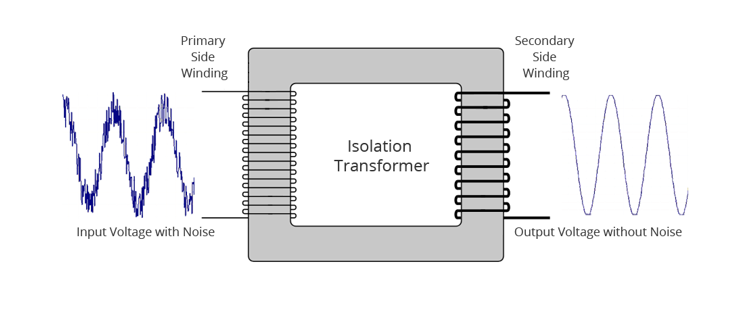What is an Isolation Transformer?
An isolation transformer is a type of transformer used to transfer electrical power from an alternating current (AC) power source to a device or circuit while isolating the powered device from the power source. This is achieved without direct electrical connection, providing safety and noise reduction benefits.
How Does an Isolation Transformer Work?
Same as a normal transformer, it works on the basic principle of electromagnetic induction, where electrical energy is transferred between two or more coils (windings) through a magnetic field. The primary and secondary windings of an isolation transformer are physically separated but magnetically coupled.
The operation of an isolation transformer is governed by Faraday’s Law of Electromagnetic Induction, which states:

- 𝑉𝑝 = Primary voltage
- 𝑉𝑠 = Secondary voltage
- 𝑁𝑝 = Number of turns in the primary winding
- 𝑁𝑠 = Number of turns in the secondary winding
- Φ = Magnetic flux





This confirms that the voltage is transferred from the primary to the secondary winding without change, but with electrical isolation.
Why is an Isolation transformer used?
Isolation transformers have several key applications:
01. Safety:
Isolation transformers protect users and sensitive equipment from electric shock by isolating the device from the direct power source.
The diagrams below explain these concepts:

- Without Isolation Transformer:
If someone accidentally touches a live wire, the current can travel through their body and complete the circuit via the ground connection, leading to an electric shock.
The Figure 1 above shows this scenario where an earth fault can occur, completing the circuit through the ground and causing potential harm.
- With Isolation Transformer:
An isolation transformer prevents direct electrical connection between the power source and the user or equipment. As in Figure 2.
In the event of an earth fault, the circuit cannot complete through the ground because the isolation transformer only allows electromagnetic field connection, not a direct electrical connection.
This means that even if someone touches a live wire, the current has no path to travel through their body to the ground, significantly reducing the risk of electric shock.
02. Noise Reduction:
They help in reducing electrical noise in sensitive equipment by isolating it from noisy power sources. Isolation transformers can help reduce electrical noise or interference that may be present in the power supply.
03. Equipment Protection:
Isolation transformers act as a barrier against voltage spikes, surges, and transient disturbances.
These transients often occur due to lightning, static electricity, or fast voltage changes. This protection is vital for sensitive electronic equipment such as computers, servers, medical devices, and telecommunications equipment, safeguarding them from potential damage or malfunction caused by power fluctuations.
Theory behind is that Isolation transformer contains winding which has inductive characteristics. This inductive property contributes to an exponential increase in current, making it incapable of generating instantaneous spikes.

Different types of Isolation transformers
- General purpose isolation transformers
- Medical isolation transformers
- Audio isolation transformers
- Pulse transformers
- Control transformers
- Power isolation transformers
- High frequency isolation transformers
- Nano-Crystalline Core transformers
Conclusion
Isolation transformers are critical components in ensuring electrical safety, reducing noise, and protecting sensitive equipment. By understanding the theory and application of these devices, we can appreciate their role in modern electrical and electronic systems. Their ability to provide isolation while maintaining power integrity makes them invaluable in various fields, from medical to industrial applications.
